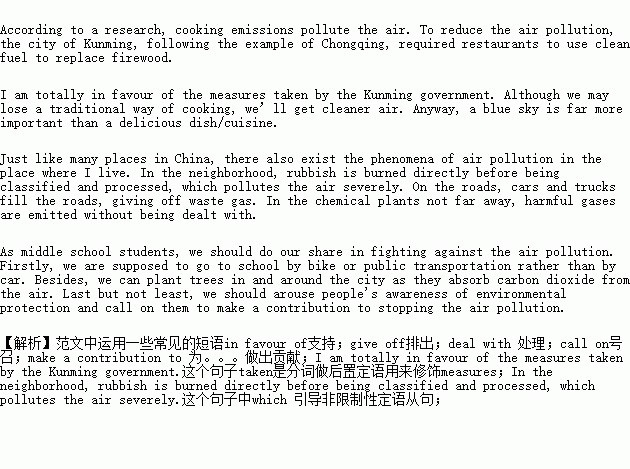题目内容
第二节 读写任务 (共1小题,满分25分)
阅读下面短文,然后按要求写一篇150词左右的英语短文。
A researcher at the Institute of Atmospheric Physics of the Chinese Academy of Sciences says that cooking emissions(排放物) is a main pollutant in the atmospheric pollution. According to the researcher, cooking emission occupies 15% to 20% in the whole PM2.5 pollution sources in the urban area in Beijing during the summer time.
Authorities in Kunming, Yunnan province, have banned restaurants from using firewood to cook a popular chicken dish in order to reduce the air pollution. The Environmental Protection Bureau of Kunming has stopped approving new restaurants that serve Chaihuoji, or firewood chicken, and asked the existing ones to replace firewood with clean fuel. Dozens of firewood chicken restaurants that opened in the past six months will need to switch to the environment-friendly fuel.
The city follows the example of Chongqing in its attempt to control smog by asking restaurants to change the way they cook some of the traditional dishes, though it remains to be seen whether the move can reduce the air pollution level. Earlier this year, Chongqing said no to smoked bacon, open-air barbecue and chicken cooked by burning firewood.
[写作内容]
1.以约30个词概括上文的主要内容。
2.以约120个词就“空气污染”这个话题谈谈你的看法,内容包括:
(1) 你对昆明“禁止燃烧柴火”举措的评价;
(2) 简述你所在地存在的空气污染现象;
(3) 作为中学生,谈谈你如何为防治空气污染作贡献。
[写作要求]
1.作文中可以使用亲身经历或虚构的故事,也可以参照阅读材料的内容,但不得直接引用原文中的句子。
2.作文中不能出现真实姓名和学校名称。
[评分标准]
概括准确,语言规范,内容合适,语篇连贯。

